The Misunderstood Laboratory Solvent: Reagent Water for HPLC
LCGC North America
Reagent water is used in all aspects of liquid chromatography (LC) technology, from preparation of mobile phase to preparation of standards, blanks, and samples. Reagent water is the most widely used analytical solvent, yet it is the least characterized, especially in total organic carbon (TOC) content. TOC adversely effects performance of LC methods and hence, reagent water quality is a major issue. Organics initially present in tap water will be reduced efficiently to low parts-per-billion concentrations by combining several technologies embedded in a water purification system. Monitoring the TOC concentrations gives chromatographers added confidence in their results.
High performance liquid chromatography (HPLC), used alone or as a chromatographic inlet for tandem detection analysis, is ubiquitous in pharmaceutical, environmental, food and beverage, organic synthesis, bioresearch, proteomics, clinical, and forensic laboratories. HPLC's versatility with respect to analyte type and concentration range demands high selectivity, specificity, and sensitivity, especially if mass spectrometry (MS) is used (1).
Reagent water is the most widely used analytical laboratory reagent and also the least well-characterized. While chromatographers take great care to ensure the purity of standards, organic solvents, and other HPLC mobile phase components, they often take reagent water quality for granted. Yet high-purity water is by far the largest mobile-phase component used for reversed-phase HPLC and LC-hyphenated methods.
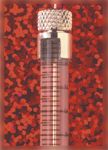
Importance of Reagent Water Quality
Reagent water quality affects nearly every aspect of HPLC analysis, from sample and standard preparation to column rinsing and elution. That makes water the largest reagent consumed in terms of volumes. In our experience, between 70% and 80% of HPLC performance problems are attributable directly to the quality of water used in preparing HPLC eluents, standards, and samples. Poor quality water reduces chromatographic performances by affecting resolution and integration, introducing ghost peaks, altering stationary phase selectivity, and impacting baselines. At high parts-per-billion levels, organic contaminants (referred to as total organic carbon or TOC) can compromise peak quantification and spectral identification of trace components.
The HPLC systems can be contaminated insidiously by a large variety of TOC sources. These include feed water, leaching from purification media, tubing and containers, bacterial contamination, and potentially, absorption from the atmosphere. For example, alkaline mobile phases are known to absorb polar organics such as formaldehyde, amines, and atmospheric carbon dioxide. For critical HPLC methods, it is preferable for chromatographers to avoid using high-purity water with a high TOC level. This includes HPLC bottled water, water that has been standing in a laboratory environment for more than 8 h (exposure to atmospheric organics), or distilled water (organics steam-distill into product water).
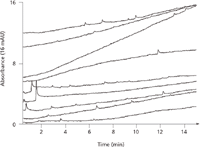
Figure 1: Isocratic baseline monitoring at 210 nm using 100% high TOC reagent water (1 mL/min). The chromatograms were obtained 1 h apart and are offset to demonstrate the effect.
As a general LC rule, many organic analytes show increasing sensitivity as the UV detection wavelength decreases. For example, at 210 nm, any organic containing a carbonyl functional group will absorb, while they would not at 254 nm. Many LC methods utilize the 210 nm wavelength.
To demonstrate the effect of TOC in the reagent water, we conducted an experiment in which several liters of high TOC reagent water (10 MΩ·cm resistivity, approximately 100 ppb TOC) were passed through a.30 mm × 2.1 mm Waters Atlantis reversed-phase C18 column, a typical LC column (Waters, Milford, Massachusetts). The experiment was run on a Waters Alliance System with a model 2996 photodiode array (PDA) detector with a 1-mL/min flow of 100% high TOC water. After several hours of flow, the isocratic baseline was monitored at 210 nm using the PDA detector (Figure 1). The chromatograms were taken 1 h apart after several hours of flow without an auto-zero trigger and are visually offset to demonstrate the effect. Note the rising baseline; several peaks observed are not reproducible. The rising baseline and peaks are not the result of a gradient chromatogram but are the consequence of high TOC bleeding off the column as it becomes saturated. Figure 2 displays comparable results with Milli-Q water. Whether the LC method is isocratic or gradient, the use of low TOC reagent water gives the best overall baseline stability and performance.
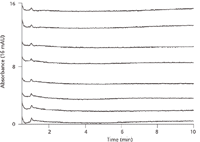
Figure 2: Overlay of 210 nm wavelength baseline obtained using high-purity water (3 ppb TOC) after continued use in isocratic conditions (1 mL/min 100% water). Chromatograms were taken 1 h apart and were offset to demonstrate the effect.
Norms such as ASTM D1193 specify that water be drawn freshly and used within 8 h. Particular attention is focused on TOC levels in reagent water, which should remain below 50 ppb (ppb = μg/L). That ASTM D1193 is lowering the TOC specifications from 100 ppb down to 50 ppb shows that scientists increasingly are aware that TOC levels in high-purity water will affect HPLC performance. Although the specification is still high, the trend of decreasing TOC levels is evident. Generally, the TOC standard of 50 ppb is accepted today, yet our experience suggests that performance and system degradation begins to affect HPLC analysis when TOC levels rise significantly above the 5-10 ppb range. The more the scientists use a chromatography system, the more likely a TOC-related problem will arise.
Figure 3 shows a comparison of five high-purity waters (18.2 MΩ·cm) with TOC levels of 2, 5, 9, 13, and 20 ppb. Baselines were monitored at 214 nm. Analyses were performed on an LC Alliance 2695 (Waters) and a model 2996 PDA detector (Waters). TOC was monitored on-line with an A10 system from Millipore Corporation (Billerica, Massachusetts). Samples of water were enriched on a 150 mm × 4.6 mm, 3.5-μm dp Symmetry C18 column (Waters) for 1 h at 1 mL/min. A linear gradient was run from 95% water (Milli-Q Gradient system, Millipore) to 100% acetonitrile (J.T. Baker, Deventer, The Netherlands) in 30 min then 10 min at 100% acetonitrile. At 2 ppb, the baseline shows only minor peaks. As the TOC concentration rises from 5 ppb to 20 ppb, the area of peaks increases accordingly, and more contaminant peaks appear, representative of what is observed in a blank gradient profile.
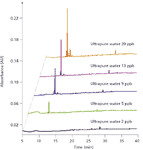
Figure 3: Overlay of the effect of increasing TOC levels on HPLC baselines (214 nm).
Decreasing TOC Level and Maintaining Constant Quality
A water purification chain designed to produce high-purity water for HPLC applications requires a combination of several technologies. Figure 4 shows the purification chain divided into two basic parts. The pretreatment involves an initial purification system and produces pure water that is stored in a reservoir. The final purification system, or so-called polishing unit, delivers ultrapure water. A good pretreatment system combines reverse osmosis and electrodeionization technologies. Following a protective pretreatment pack, water is processed through a spiral thin-film composite (polyamide and polysulfone) semipermeable reverse-osmosis membrane. Reverse osmosis is a widely used technology that removes the bulk of the contaminants, including organics, present in the tap feed water (2). The reverse-osmosis permeate water then is directed to an electrodeionization module, which combines ion-exchange membranes, ion-exchange resins, and an electrical current. The current continuously regenerates the ion-exchange resins, which avoids the need for resin replacement. The storage reservoir, made of polyethylene, is chosen for its low-release of organic extractables (3). Water then feeds the final polishing unit to remove traces of residual organics. Figure 4 shows typical levels of TOC throughout the purification chain starting from a 1-mg/L (1-ppm) level in feed water.

Figure 4: Combination of water purification technologies used to provide high-purity reagent water (Milli-Q Gradient water).
One possible polishing unit, the Milli-Q Gradient system, delivers ultrapure water treated by UV photooxidation, ion exchange, and activated carbon. The photooxidation process employs a dual-wavelength (λ = 185 nm and 254 nm) low-pressure mercury UV lamp that causes organic molecules to break up. This wavelength combination induces the generation of hydroxyl radicals from dissolved oxygen and water through singlet oxygen and ozone. Hydroxyl and secondary free radicals react with organic molecules to induce the breakup of carbon-carbon bonds. Chain radical reactions generate carbon dioxide, the end product of organic molecule oxidation (4). Carbon dioxide then reacts with water to generate carbonic acid, which at neutral pH forms monobasic carbonate. It is then removed by ion-exchange resins. At the point of use, a final 0.22-μm filter removes particulates and prevents bacterial retrocontamination of the polishing unit. If the filter is not replaced frequently, bacteria can grow on the downstream surface of the final filter, which comes into contact with air. It is recommended to always flush at least 100 mL of water through the drain before collecting water for HPLC analysis.
Previous experiments were conducted to document the impact of the TOC level on HPLC baselines and LC-MS (5,6). In the study presented here (Figure 5), double-distilled water (TOC equal to 50 ppb, Aquatron A4D system, Bibby Sterilin Ltd, UK) was compared with water at 18.2 MΩ·cm and TOC equal to 25 ppb (Simplicity system, Millipore), as well as to Milli-Q Gradient (Millipore) water at 18.2 MΩ·cm and TOC equal to 2 ppb. Reagent water was enriched on a 30 mm × 4.6 mm, 3.5-μm dp XTerra C18 precolumn (Waters) during 1 h at a flow rate of 1 mL/min. Then a gradient was run from 100% water (Milli-Q Gradient system) to 100% acetonitrile (J.T. Baker) on the 150 mm × 2.1 mm, 3.5-μm dp XTerra MSC18 precolumn (Waters). Baselines were monitored at 210 nm. This graph highlights the effect of three types of water quality on the baseline. The Milli-Q Gradient system baseline, as described in Figure 5, is significantly lower with less contaminant peaks than other types of water.

Figure 5: Comparison of three water types at 210 nm: double-distilled water (red, 50 ppb TOC), 25 ppb TOC reagent water (green, 18.2 MΩ÷cm), and 2 ppb TOC reagent water (blue, 18.2 MΩ÷cm).
Importance of TOC Monitoring
On-line monitoring essentially ensures high-purity water quality and that the system operates within specifications. TOC is difficult to quantify in terms of molar or per-weight concentrations because of the vast variability in organic structures. Every organic compound differs in carbon content. For example, 50 μg/L of methanol corresponds to 20 ppb of TOC, whereas 50 μg/L of benzoquinone corresponds to 33.3 ppb of TOC. One approach, incorporated in a Millipore polishing system, employs complete UV photooxidation of organics to carbon dioxide by a dual-wavelength UV lamp (254 and 185 nm). The TOC measurement is based upon the differential conductivity between before and after photooxidation. The amount of bicarbonate generated is measured by conductivity. This technique does not require the use of internal standards, which might interfere with conductivity measurements (7).
Most water purification systems measure resistivity at the point of use. Chromatographers are not always aware that measuring TOC is as important as measuring resistivity. In the breakthrough experiment shown in Figure 6, water was stored in a reservoir after being purified by reverse osmosis. Sucrose, a noncharged, organic molecule, was added to the storage reservoir. The enriched sucrose solution then underwent purification with no UV photooxidation. Sucrose, measured with an A100 TOC analyzer (Anatel, Loveland, Colorado), was retained by activated carbon for 120 min, and then broke through the polishing unit. Not only does Figure 6 indicate that a correlation between resistivity and TOC cannot be made, but also that monitoring both is necessary. Monitoring TOC levels has become a requirement to comply with norms and standards, but more importantly, it brings information and safety to the analyses.
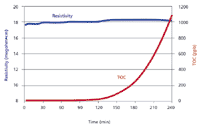
Figure 6: Monitoring of resistivity and TOC (sucrose) in parallel.
Conclusion
Organizations that rely on HPLC analysis are under constant pressure to improve productivity and minimize downtime. Few factors affect the quality of HPLC work more than the use of reagent water that contains ionic and organic contaminants. While poor water quality is one of the easiest problems to fix, it is one of the least-understood factors in an analytical laboratory.
The switch from simple resistivity measurement to resistivity and TOC monitoring represents a paradigm change in how reagent water is characterized. That shift in philosophy is accompanied by HPLC analysis that is more reliable, less prone to systematic errors, less expensive, and more productive.
Acknowledgments
The authors would like to thank J. Plurad, Millipore Corporation, for his contributions to the preparation of this manuscript.
References
(1) W.M.A. Niessen,
J. Chromatogr., A
856
(1,2), 179-197 (1999).
(2) W. Byrne, Reverse Osmosis — A Practical Guide for Industrial Users. 2nd ed. (Tall Oaks Publishing, Littleton, Colorado, 2002).
(3) D. Darbouret, I. Kano, E. Youf, and B. Stewart, "Optimizing Storage of Purified Water for Laboratory Applications," R&D Notebook 001, Millipore Corporation, Billerica, Massachusetts, 1999.
(4) B. Srikanth, Ultrapure Water 15(3), 40-46 (1998).
(5) C. Regnault, I. Kano, D. Darbouret, and S. Mabic, J. Chromatogr., A 1030(1-2), 289-295 (2004).
(6) B. Stewart and B. Williamson, Am. Biotechnol. Lab., 16-18, December 2001.
(7) K. Clark, M. Retzik, and D. Darbouret, Ultrapure Water 14(2), 21-24, (1997).
Stéphane Mabic is the worldwide application support manager for Millipore Corporation, Billerica, Massachusetts.
Cecilia Regnault is the LC-MS support scientist in the Lab Water Division of Millipore Corporation, 78054 St. Quentin en Yvelines Cedex, France. She can be reached at the following e-mail address: cecilia_regnault@millipore.com.
Jim Krol is currently senior applications chemist with Waters Corporation, Milford, Massachusetts.

Common Challenges in Nitrosamine Analysis: An LCGC International Peer Exchange
April 15th 2025A recent roundtable discussion featuring Aloka Srinivasan of Raaha, Mayank Bhanti of the United States Pharmacopeia (USP), and Amber Burch of Purisys discussed the challenges surrounding nitrosamine analysis in pharmaceuticals.
Extracting Estrogenic Hormones Using Rotating Disk and Modified Clays
April 14th 2025University of Caldas and University of Chile researchers extracted estrogenic hormones from wastewater samples using rotating disk sorption extraction. After extraction, the concentrated analytes were measured using liquid chromatography coupled with photodiode array detection (HPLC-PDA).









